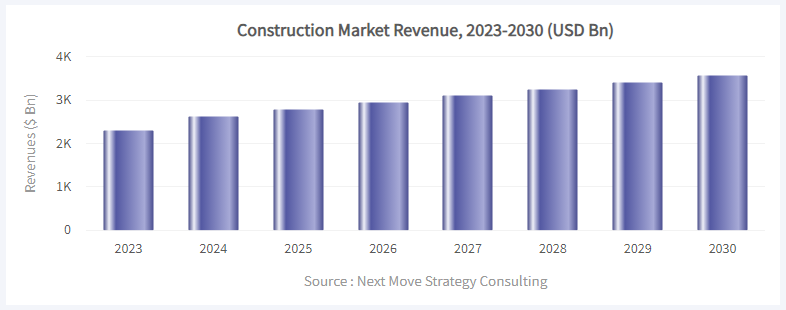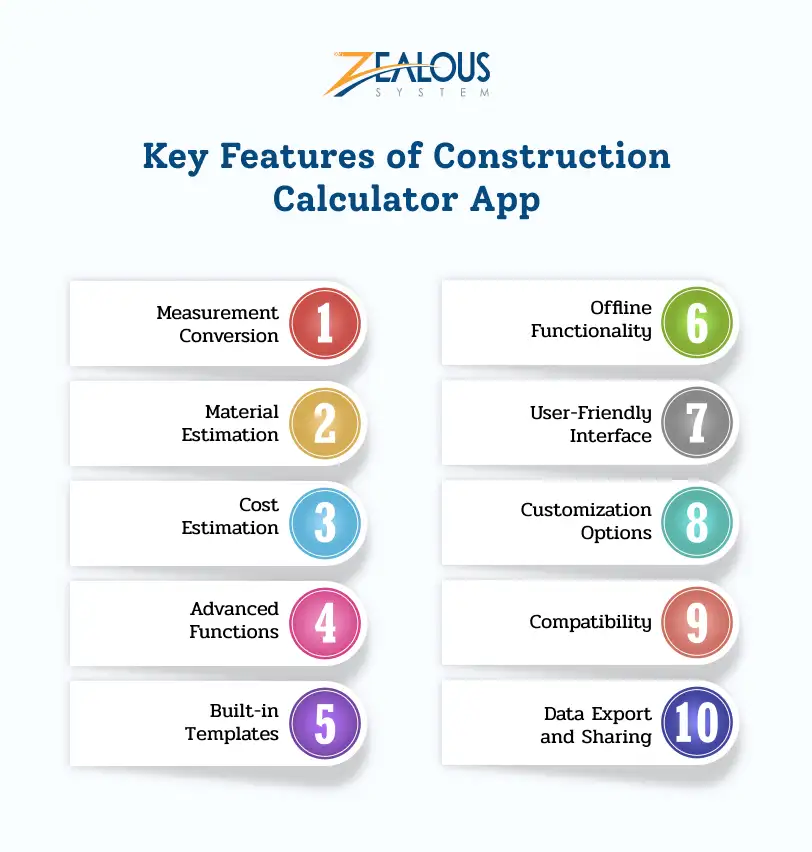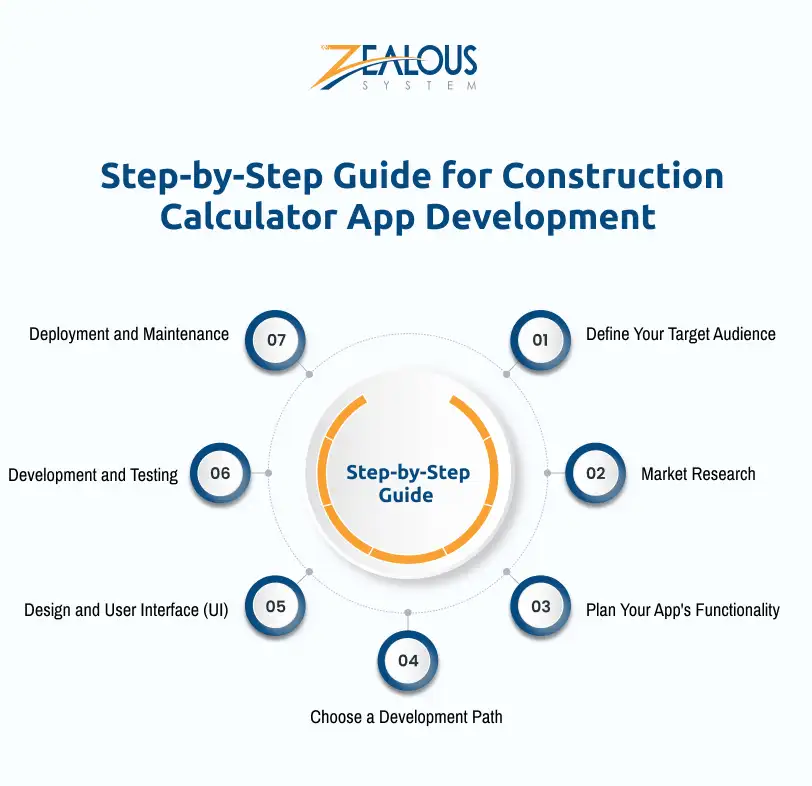


The construction industry depends on precise measurements, material estimates, and cost calculations to complete projects successfully. Manual calculations take time and often lead to errors, causing inefficiencies and budget overruns. A construction calculator app solves this problem by providing a fast and accurate digital solution for complex calculations.
Developing a construction calculator app helps businesses and contractors streamline workflows, improve accuracy, and boost productivity. Whether calculating concrete, wood, steel, or paint, a well-designed app removes guesswork and delivers instant results.
If you plan to build a construction calculator app, it’s essential to understand its benefits, key features, and development process. This guide will explain everything you need to create an app that meets the needs of modern construction professionals.
The construction industry market size was valued at USD 2319.20 billion in 2023, and is predicted to reach USD 3579.78 billion by 2030, with a CAGR of 5.9% from 2024 to 2030.
The World Bank’s latest report reveals that the Gross Domestic Product (GDP) growth rates of major economies, including India, Saudi Arabia, and Argentina among others, are undergoing substantial growth. For example, the annual GDP growth rate of Saudi Arabia is recorded at 8.7%, followed by India by 7.2%, and Argentina by 5.0% in 2022.
This growth trajectory is indicative of a robust expansion in economic activities across these regions, particularly in the construction sector. With the surge in GDP growth rates in these countries, the construction sector is poised for even greater expansion, leading to further economic development and prosperity.

A construction calculator app is a mobile or web tool that helps construction professionals, engineers, and builders make accurate calculations for materials, measurements, and costs. These apps can calculate areas, estimate volumes, determine material needs, and predict labor costs, helping projects stay within budget and on schedule.
Developing a construction calculator app focuses on simplifying complex calculations, reducing manual work, and improving efficiency. With features like real-time calculations, unit conversions, and customizable templates, these apps support various construction projects, from small home renovations to large infrastructure developments.
A best construction calculator app offers a multitude of benefits to professionals and enthusiasts in the construction industry. Here’s a breakdown of some key advantages:
Manual calculations can lead to human errors, causing material wastage and budget overruns. A construction calculator app automates these calculations, ensuring precision in material estimates and reducing costly mistakes.
Manually computing construction values is time-consuming and prone to delays. When you develop a construction calculator app, builders, contractors, and engineers can get instant, real-time calculations, allowing them to complete projects faster. The app eliminates repetitive calculations, streamlining workflows and reducing unnecessary delays.
A construction calculator app helps professionals track costs, estimate budgets accurately, and avoid financial overruns. By providing precise material and labor cost calculations, the app ensures that every aspect of a project stays within the allocated budget. This feature is particularly useful for contractors and project managers who need real-time cost insights.
A well-designed construction calculator app offers an intuitive and easy-to-navigate interface. Whether a seasoned contractor or a DIY enthusiast, users can quickly input values, get results, and modify calculations effortlessly. The app simplifies complex mathematical operations, making it accessible to users with different levels of expertise.
Builders and contractors often work with different materials like concrete, steel, wood, bricks, and flooring. A well-built construction calculator app supports multiple material types, allowing users to perform various calculations in one place. Whether calculating concrete volume, rebar lengths, or flooring measurements, the app ensures accuracy across different project needs.
Every construction project has unique requirements. A custom-built construction calculator app allows users to customize features like unit measurements, currency settings, and project templates. This flexibility ensures that professionals can tailor the app to meet their specific needs, making project planning more efficient.

Here are some key features that contribute to the value of the best construction calculator app:
The best construction calculator app should offer quick and accurate conversion between different units of measurement commonly used in construction, such as feet to meters, square feet to square meters, cubic yards to cubic meters, etc.
This feature allows users to calculate the quantity of materials needed for a project based on dimensions entered. Whether it’s concrete, bricks, lumber, or paint, the construction calculator app should provide precise construction estimates, helping users avoid over or under-ordering materials.
Beyond material quantities, users often need to estimate the cost of a project. A construction material calculator app should include features to calculate material costs, labor costs, equipment costs, and other expenses to provide an accurate project budget.
For more complex projects, advanced functions such as trigonometric calculations for roof pitches, slope angles, and stair dimensions are essential. These construction calculator app development functions enable users to tackle intricate aspects of construction with ease and accuracy.
Pre-set templates for common construction calculations, such as concrete volume for slabs, framing materials for walls, or paint quantities for rooms, can save users time and effort by providing standardized starting points.
Construction sites often lack reliable internet access, so an builder calculator app that works offline is crucial. Users should be able to access all features and data without an internet connection, ensuring uninterrupted productivity.
The construction material calculator app should have an intuitive interface that is easy to navigate, even for users who may not be tech-savvy. Clear instructions and helpful tooltips can enhance the user experience and reduce frustration.
Every construction project is unique, so the ability to customize settings and preferences is valuable. Users should be able to adjust units of measurement, currency, and other parameters to suit their specific needs, which is essential during construction calculator app development.
The construction calculator app should be available on multiple platforms, including iOS, Android, and web browsers, to accommodate users who may prefer different devices or operating systems.
The ability to export calculations, estimates, and reports in various formats (such as PDF or spreadsheet) and share them with colleagues, clients, or subcontractors is essential for collaboration and construction project management.
Construction material calculator apps provide many advantages, but creating them comes with some challenges. Here’s a simple overview of key issues and possible solutions:
Construction calculations must be precise and follow building codes. Mistakes can lead to high costs and safety risks.
Solution: Conduct thorough testing, including unit testing and user acceptance testing, to find and fix errors. Regularly update the app to stay aligned with the latest building codes and industry standards.
Calculating materials can be complicated. The app should be easy to use for both professionals and DIY users.
Solution: Focus on a clean design with clear instructions. Use features like drop-down menus and helpful prompts to guide users through the app. Aim to make it one of the best construction calculator apps available.
Construction projects involve sensitive information, such as material costs and project details. The app must protect this data.
Solution: Use strong security measures, like encryption and user authentication. Clearly communicate data privacy practices and comply with relevant regulations.
Construction materials and regulations change over time. The app must reflect these updates to stay relevant.
Solution: Build a system for regular updates. Stay informed about industry trends and incorporate them into the app’s features.
Construction sites often lack reliable internet access. The app should work offline.
Solution: Design the app so key features, like basic calculators and unit conversion tools, can function without internet access. This makes it a practical builders calculator app for any job site.
By addressing these challenges, developers can create a construction calculator app that is effective, user-friendly, and essential for any construction project.

Developing a construction calculator app involves several key steps to ensure its success and effectiveness. Here’s a step-by-step guide to help you navigate the process:
Identify the primary users of your construction calculator app, such as construction professionals, contractors, architects, or DIY enthusiasts. Understand their needs, preferences, and pain points to tailor the app’s features and functionality to meet their requirements effectively.
Conduct thorough market research to assess the demand for construction material calculator apps and understand the competitive landscape. Identify existing apps, their strengths and weaknesses, and opportunities for differentiation. Gather feedback from potential users to validate your app concept and refine your strategy accordingly.
Define the core features and functionalities of your builder calculator app based on your target audience’s needs and market research findings. Consider including features such as measurement conversion, material estimation, cost estimation, advanced calculations, offline functionality, customization options, and collaboration tools.
Decide whether to develop your construction calculator app natively for specific platforms (e.g., iOS, Android) or use cross-platform development frameworks to build a single codebase for multiple platforms. Consider factors such as development time, cost, performance, and user experience when choosing the development path.
Create a visually appealing and intuitive user interface (UI) design for your construction calculator app. Focus on simplicity, clarity, and ease of use to ensure a positive user experience. You can use wireframes, mockups, and prototypes to visualize the app’s layout, navigation, and interactions before proceeding with mobile app development.
Develop the construction calculator app according to the planned functionality and UI design. Follow best practices for coding, architecture, and performance optimization to ensure the app’s reliability, scalability, and maintainability. Conduct thorough testing, including functional testing, usability testing, and performance testing, to identify and fix any bugs or issues before launch.
Prepare your construction calculator app for deployment to the app stores (e.g., Apple App Store, Google Play Store) or distribution through other channels. Follow the platform-specific guidelines and requirements for app submission, including app store listings, metadata, screenshots, and promotional materials.
Consider localization and internationalization if you plan to target users in different regions or languages. Once launched, continue to monitor the app’s performance, gather user feedback, and make updates and improvements as needed. Provide responsive customer support to address user inquiries, issues, and suggestions promptly.
The cost of building a construction material calculator app can vary significantly depending on several factors. Here’s a breakdown to give you a general idea:
A basic construction calculator app with essential features such as measurement conversion, basic material estimation, and a simple user interface can cost anywhere between $5,000 to $15,000.
This estimate includes development for a single platform (either iOS or Android) and may not include advanced functionalities or customization options.
A construction material calculator app with medium complexity, including features such as advanced calculations (e.g., trigonometric functions), customizable templates, offline functionality, and support for multiple platforms (iOS and Android), can cost between $15,000 to $30,000.
This estimate cost for additional app development time and resources required to implement more advanced features and ensure compatibility across different platforms.
An advanced construction calculator app with advanced features such as real-time collaboration, cloud synchronization, extensive customization options, integration with third-party APIs or databases, and robust security measures can cost upwards of $30,000 or more.
The complexity and sophistication of such apps require significant development effort, testing, and ongoing maintenance to ensure reliability and performance.
Construction calculator apps have the potential to revolutionize the construction industry by empowering professionals with on-site calculation tools and project management aids. By following a well-defined development process and prioritizing user needs, you can build an app that enhances efficiency, streamlines workflows, and ultimately contributes to successful construction projects.
To bring your vision to life, you can hire mobile app developer or get in touch with a mobile application development company with expertise in construction-related apps. Their experience and skills can help you navigate the complexities of app development and deliver a high-quality solution that meets the unique requirements of the construction industry.
Our team is always eager to know what you are looking for. Drop them a Hi!
Comments